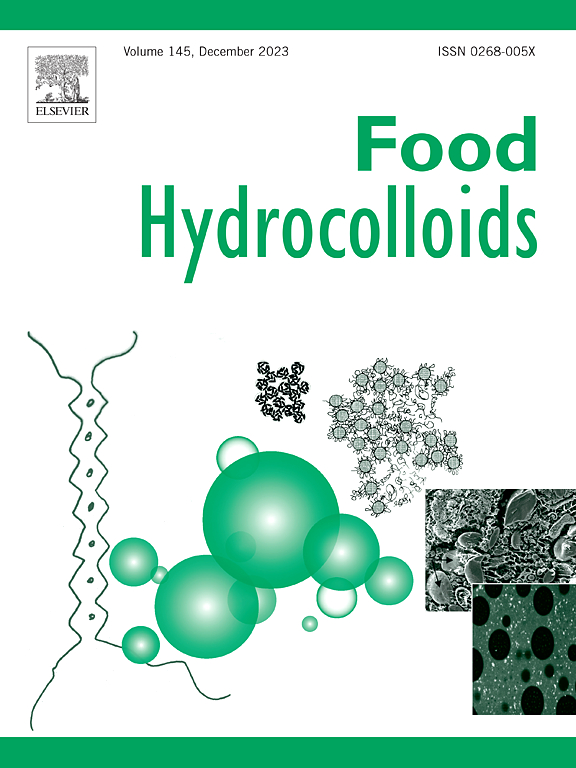Synergistic effects of heating and ultrasonic co-treatment on pea protein functionality: Self-assembled protein carriers for enhanced resveratrol solubility
IF 11
1区 农林科学
Q1 CHEMISTRY, APPLIED
引用次数: 0
Abstract
A sequential heating and ultrasonic co-treatment was developed to structurally modify pea protein (PP) and enhance its performance as a self-assembled nanocarrier for resveratrol (RES). The impact of this co-treatment on PP's molecular structure and its subsequent RES encapsulation efficiency via pH-driven self-assembly was evaluated. Structural characterization confirmed that the treatment induced significant molecular reconfigurations, including covalent cross-linking through carbonyl formation, amino group oxidation, and sulfhydryl-to-disulfide bond conversion. These modifications directly improved the functional properties of PP. The optimal treatment (20 min heating followed by 30 min sonication, H20U30) increased PP solubility by 194.77 % compared to the untreated control. Subsequent self-assembly with RES was most effective under alkaline conditions, a process governed predominantly by hydrophobic interactions and van der Waals forces. This treatment enhanced the resveratrol loading capacity of the pea protein by 115.19 % relative to its native counterpart. These findings demonstrate that sequential heating-ultrasound treatment is an effective strategy for engineering PP, markedly improving its solubility and capacity for encapsulating poorly soluble nutraceuticals. This pre-modification approach represents a valuable method for developing advanced delivery systems in functional foods.

加热和超声共处理对豌豆蛋白功能的协同效应:自组装蛋白载体增强白藜芦醇的溶解度
采用连续加热和超声共处理技术对豌豆蛋白(PP)进行了结构修饰,提高了其作为白藜芦醇(RES)自组装纳米载体的性能。评估了这种共处理对PP分子结构的影响,以及随后通过ph驱动的自组装对其RES包封效率的影响。结构表征证实,处理诱导了显著的分子重构,包括通过羰基形成的共价交联、氨基氧化和巯基到二硫键的转化。这些修饰直接改善了PP的功能性能。最佳处理(加热20 min,超声30 min, H20U30)使PP的溶解度比未处理的对照组提高了194.77%。随后与RES的自组装在碱性条件下最有效,这一过程主要由疏水相互作用和范德华力控制。该处理使豌豆蛋白的白藜芦醇负载能力比天然处理提高了115.19%。这些发现表明,连续加热-超声处理是工程PP的有效策略,显着提高其溶解度和封装难溶性营养药品的能力。这种预修饰方法为开发功能食品的先进输送系统提供了一种有价值的方法。
本文章由计算机程序翻译,如有差异,请以英文原文为准。
求助全文
约1分钟内获得全文
求助全文
来源期刊

Food Hydrocolloids
工程技术-食品科技
CiteScore
19.90
自引率
14.00%
发文量
871
审稿时长
37 days
期刊介绍:
Food Hydrocolloids publishes original and innovative research focused on the characterization, functional properties, and applications of hydrocolloid materials used in food products. These hydrocolloids, defined as polysaccharides and proteins of commercial importance, are added to control aspects such as texture, stability, rheology, and sensory properties. The research's primary emphasis should be on the hydrocolloids themselves, with thorough descriptions of their source, nature, and physicochemical characteristics. Manuscripts are expected to clearly outline specific aims and objectives, include a fundamental discussion of research findings at the molecular level, and address the significance of the results. Studies on hydrocolloids in complex formulations should concentrate on their overall properties and mechanisms of action, while simple formulation development studies may not be considered for publication.
The main areas of interest are:
-Chemical and physicochemical characterisation
Thermal properties including glass transitions and conformational changes-
Rheological properties including viscosity, viscoelastic properties and gelation behaviour-
The influence on organoleptic properties-
Interfacial properties including stabilisation of dispersions, emulsions and foams-
Film forming properties with application to edible films and active packaging-
Encapsulation and controlled release of active compounds-
The influence on health including their role as dietary fibre-
Manipulation of hydrocolloid structure and functionality through chemical, biochemical and physical processes-
New hydrocolloids and hydrocolloid sources of commercial potential.
The Journal also publishes Review articles that provide an overview of the latest developments in topics of specific interest to researchers in this field of activity.
 求助内容:
求助内容: 应助结果提醒方式:
应助结果提醒方式:


